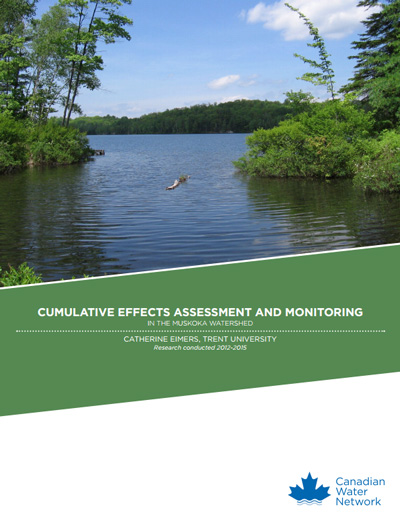Managing Cumulative Effects in the Muskoka River Watershed: Monitoring, Research and Predictive Modeling
Dr. Catherine Eimers, Associate Professor, Department of Geography, Trent University (2012-2014)

Challenge
There are more than 2,000 lakes in the Muskoka River watershed, which is in the heart of Ontario’s cottage county and provides many ecological services — supplying source water, regulating wastewater for numerous communities, maintaining biodiversity, and preserving natural habitats. This watershed also offers an abundance of recreational and fishing opportunities. Many of these essential ecological services rely on water quality, which is being degraded by a variety of stressors. Phosphorous levels in the watershed have dropped unexpectedly, potentially lowering fish productivity and changing the phytoplankton communities on which other organisms depend. Calcium levels have also declined, potentially impairing the growth and health of many ecologically essential crustaceans. Dissolved organic carbon and salinity have risen in many lakes and streams, with unknown impacts on nutrient availability, lake thermal properties and biodiversity.
This project addresses the needs of Muskoka River Watershed Monitoring and Management Consortium to develop best practices for a collaborative monitoring program to detect cumulative effects of multiple stressors in the watershed. The project looks to determine the causes and implications of changes in key stressors and to develop a predictive model so that the Consortium can manage the Muskoka River watershed better both today and in the future.
Project
To support a cumulative effects monitoring program in the Muskoka River watershed, the research team conducted a series of 11 inter-related studies that:
- Derived a conceptual model of multiple stressors (phosphorous, calcium, salinity and dissolved organic carbon) and of cumulative effects for the Muskoka River watershed
- Evaluated physical, chemical and biological stressors and response indicators, and characterized baseline conditions in the Muskoka River Watershed, the foundation of a cumulative-effects monitoring program
- Modelled and predicted the cumulative effects of multiple stressors
In addition to generating findings to meet the Muskoka River Watershed Monitoring and Management Consortium’s research needs, this project is also providing exceptional training opportunities for nine graduate students and two postdoctoral fellows.
Outputs
- Muskoka WaterWeb website to disseminate the project’s findings to all stakeholders and include a summary of the project’s 11 inter-related studies and their individual goals. Research and monitoring results will be published as they become available.
- A final report and presentation to summarize recommendations for the monitoring and modelling framework to the District of Muskoka.
- Development of predictive model of the cumulative effects of multiple stressors.
Outcomes
- Development of best practices for a collaborative monitoring program to detect cumulative effects of multiple stressors in the watershed
- Improved management of the current and future effects of multiple stressors in the Muskoka River Watershed
- Potential changes in practice related to the development of predictive models





